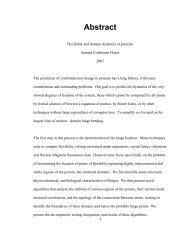The Real Life of Pseudogenes Disabled genes, molecular - People
The Real Life of Pseudogenes Disabled genes, molecular - People
The Real Life of Pseudogenes Disabled genes, molecular - People
You also want an ePaper? Increase the reach of your titles
YUMPU automatically turns print PDFs into web optimized ePapers that Google loves.
Nature may have figured out<br />
a way to reuse the<br />
broken parts <strong>of</strong> <strong>genes</strong>.<br />
gene’s mRNA transcript into a functional<br />
protein. And at least two examples <strong>of</strong><br />
pseudo<strong>genes</strong> behaving in a similar manner<br />
have been documented so far.<br />
<strong>The</strong> first was reported in 1999 by<br />
Michael O’Shea’s research group at the<br />
University <strong>of</strong> Sussex in England. <strong>The</strong> investigators<br />
found that in the neurons <strong>of</strong><br />
a common pond snail, both the gene for<br />
nitric oxide synthase (NOS) and its related<br />
pseudogene are transcribed into<br />
RNA but that the RNA transcript <strong>of</strong> the<br />
NOS pseudogene inhibits protein production<br />
from the transcript <strong>of</strong> the normal<br />
NOS gene.<br />
<strong>The</strong>n, in 2003, Shinji Hirotsune <strong>of</strong><br />
the Saitama Medical School in Japan<br />
traced deformities in a group <strong>of</strong> experimental<br />
baby mice to the alteration <strong>of</strong> a<br />
pseudogene. <strong>The</strong> inactivity <strong>of</strong> an important<br />
regulatory gene called Makorin1<br />
had derailed the development <strong>of</strong> the<br />
mice, but Hirotsune had not done anything<br />
to Makorin1. He had accidentally<br />
disrupted the Makorin1 pseudogene,<br />
which affected the function <strong>of</strong> its counterpart,<br />
the Makorin1 gene.<br />
Perhaps two dozen examples <strong>of</strong> specific<br />
pseudo<strong>genes</strong> that appear to be active<br />
in some way—<strong>of</strong>ten only in certain cells<br />
<strong>of</strong> an organism—have been identified, although<br />
the findings are still preliminary.<br />
Because many pseudo<strong>genes</strong> have sequences<br />
highly similar to those <strong>of</strong> their<br />
parent <strong>genes</strong>, it is very tempting to speculate<br />
that the NOS and Makorin1 pseudo<strong>genes</strong><br />
are not just isolated cases. Yet it is<br />
hard to imagine that these two pseudo<strong>genes</strong><br />
had the specific roles they now perform<br />
when they first arose. Instead their<br />
activity may be the result <strong>of</strong> selection<br />
preserving happy accidents or <strong>of</strong> nature<br />
having figured out an efficient way to reuse<br />
the broken parts <strong>of</strong> <strong>genes</strong> by converting<br />
them into regulatory elements.<br />
M O R E T O E X P L O R E<br />
Proto<strong>genes</strong><br />
a n e xci t i ng er a <strong>of</strong> <strong>molecular</strong> paleontology<br />
is just beginning. We have<br />
barely scratched the surface <strong>of</strong> the pseudogene<br />
strata, and once we drill deeper,<br />
the number <strong>of</strong> identified pseudo<strong>genes</strong><br />
will most likely grow and we may find<br />
more surprises. Large-scale pseudogene<br />
identification is a very dynamic datamining<br />
process. Current techniques rely<br />
heavily on sequence comparison to wellcharacterized<br />
<strong>genes</strong>, and although they<br />
can readily identify recently generated<br />
pseudo<strong>genes</strong>, very ancient and decayed<br />
sequences are probably escaping detection.<br />
As the sequence and annotation <strong>of</strong><br />
the human genome itself are refined and<br />
updated, characterization <strong>of</strong> pseudo<strong>genes</strong><br />
will improve as well.<br />
Recent hints that not all pseudo<strong>genes</strong><br />
are entirely dead have been intriguing,<br />
and some evidence also exists for the<br />
possibility <strong>of</strong> pseudogene resurrection—<br />
a dead gene turning back into a living<br />
one that makes a functional protein<br />
product. Careful sequence comparisons<br />
have shown that one cow gene for a ribonuclease<br />
enzyme was a pseudogene<br />
for much <strong>of</strong> its history but appears to<br />
have been reactivated during recent evolutionary<br />
time. Slight differences in the<br />
pseudogene complements <strong>of</strong> individual<br />
people have also been found—for example,<br />
a few olfactory receptor pseudo<strong>genes</strong><br />
straddle the fence: in most people<br />
they are pseudo<strong>genes</strong>, but in some they<br />
are intact, working <strong>genes</strong>. <strong>The</strong>se anomalies<br />
could arise if random mutation reversed<br />
the disablement that originally<br />
produced the pseudogene. Might they<br />
account for individuals’ differing sensitivities<br />
to smell Perhaps, although it is<br />
too early to guess at the scope or significance<br />
<strong>of</strong> this unexpected source <strong>of</strong> genetic<br />
variation among humans.<br />
Our studies have suggested, however,<br />
that in yeast, certain cell-surface protein<br />
pseudo<strong>genes</strong> are reactivated when the<br />
organism is challenged by a stressful<br />
new environment. Thus, pseudo<strong>genes</strong><br />
may be considered not only as dead<br />
<strong>genes</strong> (which nonetheless provide fascinating<br />
new insights into our past) but<br />
also as potentially unborn <strong>genes</strong>: a resource<br />
tucked away in our genetic closet<br />
to be drawn on in changing circumstances,<br />
one whose possible roles in our<br />
present and future genomes are just beginning<br />
to unfold.<br />
Human Specific Loss <strong>of</strong> Olfactory Receptor Genes. Yoav Gilad et al. in Proceedings <strong>of</strong> the National<br />
Academy <strong>of</strong> Sciences USA, Vol. 100, No. 6, pages 3324–3327; March 18, 2003.<br />
<strong>Pseudo<strong>genes</strong></strong>: Are <strong>The</strong>y “Junk” or Functional DNA Evgeniy S. Balakirev and Francisco J. Ayala<br />
in Annual Review <strong>of</strong> Genetics, Vol. 37, pages 123–151; December 2003.<br />
Large-Scale Analysis <strong>of</strong> <strong>Pseudo<strong>genes</strong></strong> in the Human Genome. Zhaolei Zhang and Mark Gerstein<br />
in Current Opinion in Genetics & Development, Vol. 14, No. 4, pages 328–335; August 2004.<br />
www.pseudogene.org/<br />
w w w. s c i a m . c o m S C I E N T I F I C A M E R I C A N 55<br />
COPYRIGHT 2006 SCIENTIFIC AMERICAN, INC.










